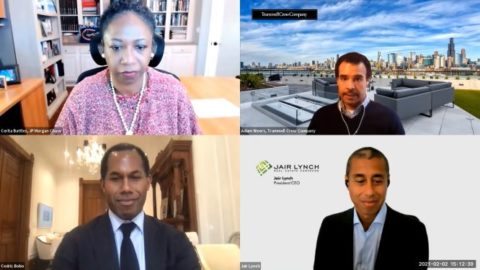Emerging Trends Series
ULI Washington hosted a regional forum, Emerging Trends 2021: Transforming the DMV, in February 2021, and more than 400 people connected online to hear leaders and development visionaries share insights into the regional economic outlook.
PwC’s Byron Carlock, U.S. Real Estate Practice Leader, kicked off the event with highlights from ULI/PwC’s Emerging Trends in Real Estate 2021 report. Now in its 42nd year, this comprehensive forecast covers real estate and development trends, real estate finance and capital markets, property sectors, metropolitan areas, and other real estate issues in the US and Canada. Carlock’s keynote address focused on how national trends identified in the new report will impact the region.
In her keynote in the opening session, Amy Liu, Brookings Institution’s Vice President and Director, Metropolitan Policy Program discussed how the regional real estate sector should use this moment to address long standing inequities and looming risks like climate change. “It’s time for a reset,” said Liu. “Thanks to the assets that our region has, we will bounce back from the pandemic. But we should use this moment to build back better with high-quality jobs, wealth creation opportunities, and the advancement of racial inclusion.”
A panel on racial equity brought together banking, nonprofit and developer leaders to share their insights on how to overcome stark racial disparities that have resulted from structural racism in real estate and land use. “The real estate industry has overlooked the intrinsic value of disinvested neighborhoods, and our approach needs to change,” said Jair Lynch, President & CEO of Jair Lynch Real Estate Partners. “Long-time residents need to see themselves as part of the redevelopment of their neighborhoods. Developers must help longtime residents stay in their homes.” Panelists discussed tax increases that detrimentally impact redeveloping neighborhoods, tax credits, renter assistance, food deserts, and how to increase financial and investment literacy.

Takeaways:
– A Positive Recovery: Despite the COVID-19 pandemic’s impact on the market, with sinking rental rates, struggling retail and office vacancy, visionaries spoke of the many positive signs of an impending recovery. The District had the nation’s fourth highest level of investment sales last year.
– A Timeframe for Recovery: How long will recovery take? Carlock predicted that it will take up to four years to work through the region’s office sublease inventory and for its convention-dependent hospitality sector to bounce back. The multifamily sector faces a 7 percent average decline in rental rates and a likely oversupply of urban luxury product, while many renters have sought out lower-density and more spacious apartments in the suburbs. The housing sector faces a dire need to provide more affordable housing for essential workers and more missing-middle housing.
–Think Big Picture: Strategic goals like job density can result in many benefits: creating vibrant communities to attract jobs and workers, while helping to achieve racial equity (since workers of color are less likely to own cars). Job density is also good for the environment, creating efficiency in land and energy usage.
– Think in Mixed-Use: Neighborhoods with a mix of housing and retail fared better during the pandemic, making the case for additional housing in previously office-centric neighborhoods throughout the region. Similarly, retail continues to grow in mixed-use neighborhoods.
– On Restaurants: Restaurants were the region’s second largest regional employer before the pandemic, and they were 96 percent independently owned and operated. More than 150 have closed in the last year, and many are rethinking their model.
–Population Change: The report highlighted projections in population change in comparison to other major markets. The District and Maryland suburbs are slated to increase population by half a percentage point in five years (.4% in Maryland suburbans), and both see 1.5% employment growth; the Northern Virginia suburbs are expected to see 1% population growth and 2.5% employment growth in the same period.
–Racial Equity & Financial Literacy: More than 100 million Americans lack financial or investment literacy, contributing to as much as 40 percent wealth gap at retirement.
Dive deeper into these topics with recordings of each session and the full reports, which are linked below.
Emerging Trends 2021: Transforming the DMV
Matt Kelly, CEO, JBG Smith
Amy Liu, Vice President, and Director, Metropolitan Policy Program, Brookings Institution
(Moderator) Willy Walker, Chairman and CEO, Walker & Dunlop
Anthony Williams, CEO, Federal City Council
Racial Equity & Real Estate
Cerita Battles, Managing Director, Affordable Lending, JPMorgan Chase
Cedric Bobo, Co-Founder, Project Destined
Jair Lynch, President & CEO, Jair Lynch Real Estate Partners
(Moderator) Adam Weers, Principal, Trammell Crow
Transforming the Retail Landscape
(Moderator) Heather Arnold, Managing Director, Streetsense
Kathy Bonnafe, CEO, Combined Creative
Kathy Hollinger, President & CEO, Restaurant Assoc. of Metropolitan Washington
Jodie McLean, CEO, EDENS

